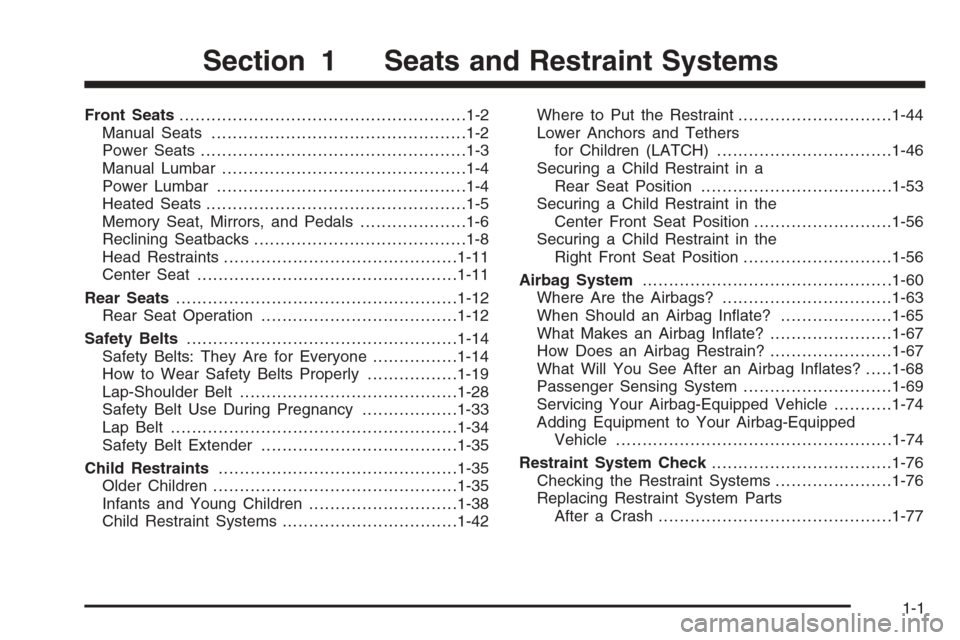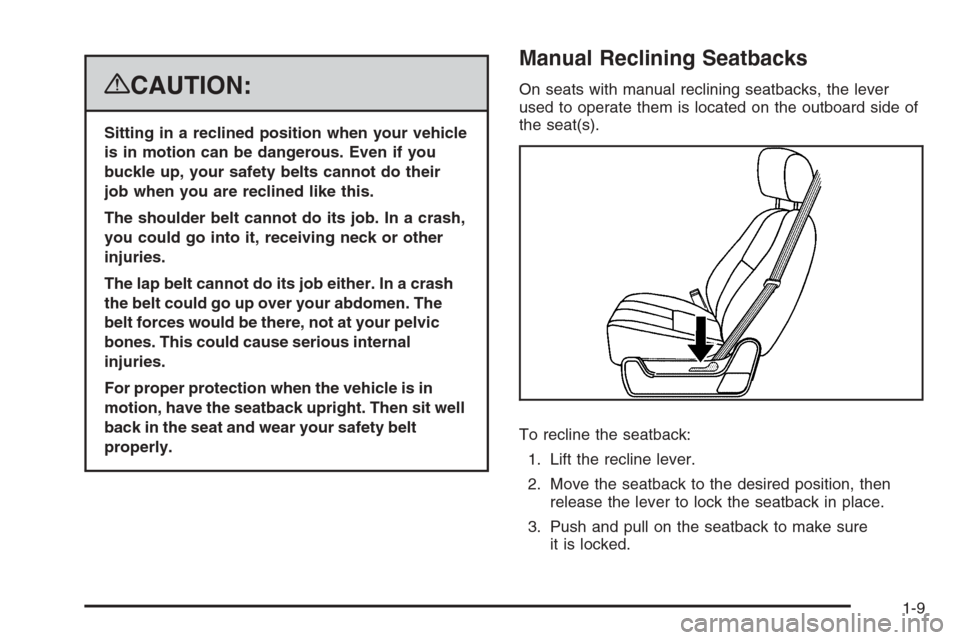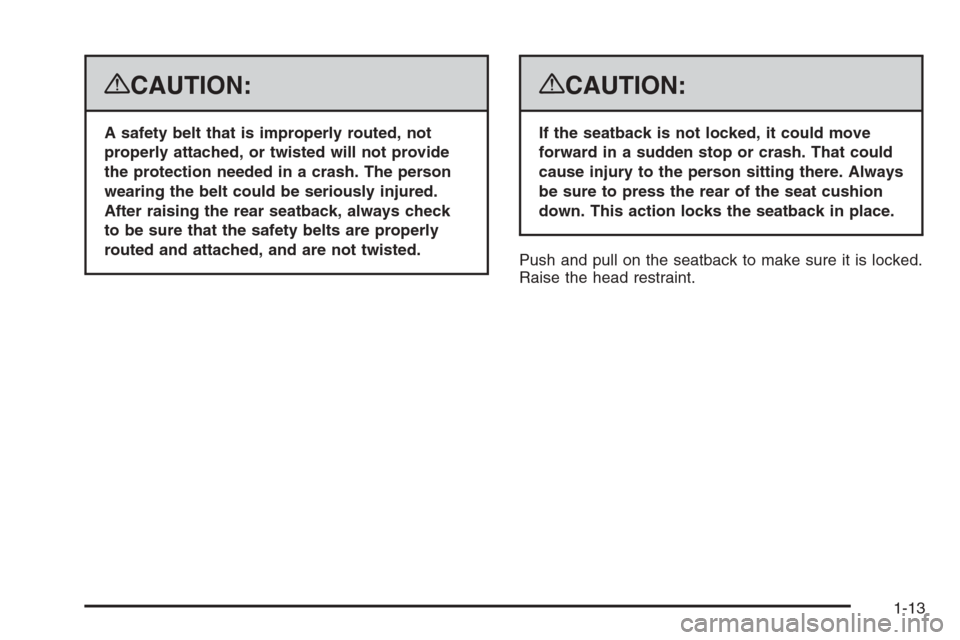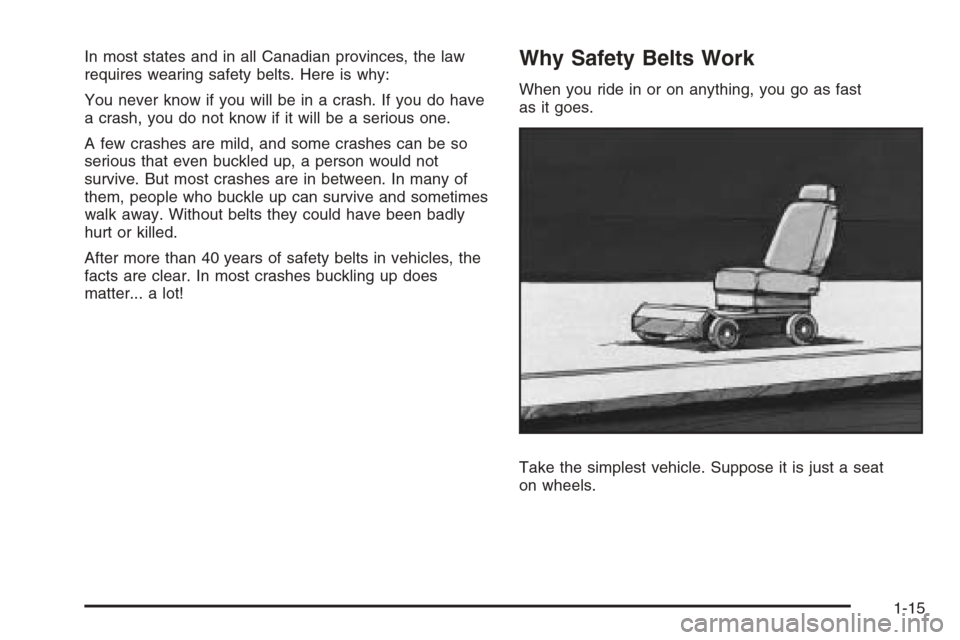2008 CHEVROLET AVALANCHE belt
[x] Cancel search: beltPage 1 of 528

Seats and Restraint Systems........................... 1-1
Front Seats
............................................... 1-2
Rear Seats
..............................................1-12
Safety Belts
.............................................1-14
Child Restraints
.......................................1-35
Airbag System
.........................................1-60
Restraint System Check
............................1-76
Features and Controls..................................... 2-1
Keys
........................................................ 2-3
Doors and Locks
......................................2-10
Windows
.................................................2-23
Theft-Deterrent Systems
............................2-26
Starting and Operating Your Vehicle
...........2-30
Mirrors
....................................................2-49
Object Detection Systems
..........................2-58
OnStar
®System
......................................2-61
Universal Home Remote System
................2-64
Storage Areas
.........................................2-71
Sunroof
..................................................2-96
Instrument Panel............................................. 3-1
Instrument Panel Overview
.......................... 3-4
Climate Controls
......................................3-21
Warning Lights, Gages, and Indicators
........3-32
Driver Information Center (DIC)
..................3-50
Audio System(s)
.......................................3-75Driving Your Vehicle....................................... 4-1
Your Driving, the Road, and Your Vehicle
..... 4-2
Towing
...................................................4-42
Service and Appearance Care.......................... 5-1
Service
..................................................... 5-3
Fuel
......................................................... 5-5
Checking Things Under the Hood
...............5-12
Rear Axle
...............................................5-47
Four-Wheel Drive
.....................................5-48
Front Axle
...............................................5-49
Headlamp Aiming
.....................................5-50
Bulb Replacement
....................................5-53
Windshield Wiper Blade Replacement
.........5-55
Tires
......................................................5-56
Appearance Care
.....................................5-99
Vehicle Identi�cation
...............................5-107
Electrical System
....................................5-108
Capacities and Speci�cations
...................5-115
Maintenance Schedule..................................... 6-1
Maintenance Schedule
................................ 6-2
Customer Assistance Information.................... 7-1
Customer Assistance and Information
........... 7-2
Reporting Safety Defects
...........................7-14
Vehicle Data Recording and Privacy
...........7-16
Index................................................................ 1
2008 Chevrolet Avalanche Owner ManualM
Page 5 of 528

Front Seats......................................................1-2
Manual Seats................................................1-2
Power Seats..................................................1-3
Manual Lumbar..............................................1-4
Power Lumbar ...............................................1-4
Heated Seats.................................................1-5
Memory Seat, Mirrors, and Pedals....................1-6
Reclining Seatbacks........................................1-8
Head Restraints............................................1-11
Center Seat.................................................1-11
Rear Seats.....................................................1-12
Rear Seat Operation.....................................1-12
Safety Belts...................................................1-14
Safety Belts: They Are for Everyone................1-14
How to Wear Safety Belts Properly.................1-19
Lap-Shoulder Belt.........................................1-28
Safety Belt Use During Pregnancy..................1-33
Lap Belt......................................................1-34
Safety Belt Extender.....................................1-35
Child Restraints.............................................1-35
Older Children..............................................1-35
Infants and Young Children............................1-38
Child Restraint Systems.................................1-42Where to Put the Restraint.............................1-44
Lower Anchors and Tethers
for Children (LATCH).................................1-46
Securing a Child Restraint in a
Rear Seat Position....................................1-53
Securing a Child Restraint in the
Center Front Seat Position..........................1-56
Securing a Child Restraint in the
Right Front Seat Position............................1-56
Airbag System...............................................1-60
Where Are the Airbags?................................1-63
When Should an Airbag In�ate?.....................1-65
What Makes an Airbag In�ate?.......................1-67
How Does an Airbag Restrain?.......................1-67
What Will You See After an Airbag In�ates?.....1-68
Passenger Sensing System............................1-69
Servicing Your Airbag-Equipped Vehicle...........1-74
Adding Equipment to Your Airbag-Equipped
Vehicle....................................................1-74
Restraint System Check..................................1-76
Checking the Restraint Systems......................1-76
Replacing Restraint System Parts
After a Crash............................................1-77
Section 1 Seats and Restraint Systems
1-1
Page 13 of 528

{CAUTION:
Sitting in a reclined position when your vehicle
is in motion can be dangerous. Even if you
buckle up, your safety belts cannot do their
job when you are reclined like this.
The shoulder belt cannot do its job. In a crash,
you could go into it, receiving neck or other
injuries.
The lap belt cannot do its job either. In a crash
the belt could go up over your abdomen. The
belt forces would be there, not at your pelvic
bones. This could cause serious internal
injuries.
For proper protection when the vehicle is in
motion, have the seatback upright. Then sit well
back in the seat and wear your safety belt
properly.
Manual Reclining Seatbacks
On seats with manual reclining seatbacks, the lever
used to operate them is located on the outboard side of
the seat(s).
To recline the seatback:
1. Lift the recline lever.
2. Move the seatback to the desired position, then
release the lever to lock the seatback in place.
3. Push and pull on the seatback to make sure
it is locked.
1-9
Page 16 of 528

Rear Seats
Rear Seat Operation
The rear seat is a 60/40 split bench seat that can be
folded to give you more cargo space and access to the
folding midgate. SeeMidgate
®on page 2-12for
more information on operation of the folding midgate.
To fold either side of the seat do the following:
1. Push the rear seat head restraints all the
way down.
2. Pull the seat loop
located where the
seatback and seat
cushion meet. The seat
cushion will release and
allow you to tilt it toward
the front of the vehicle.Notice:Folding a rear seat with the safety belts
still fastened may cause damage to the seat or the
safety belts. Always unbuckle the safety belts
and return them to their normal stowed position
before folding a rear seat.
3. Fold the seatback forward until it is �at. You
may have to move the front seats forward
slightly to do this.
4. Repeat the procedure for the other side.
To return the seats to the normal position, push
the seatback up and fold the seat cushion down.
1-12
Page 17 of 528

{CAUTION:
A safety belt that is improperly routed, not
properly attached, or twisted will not provide
the protection needed in a crash. The person
wearing the belt could be seriously injured.
After raising the rear seatback, always check
to be sure that the safety belts are properly
routed and attached, and are not twisted.
{CAUTION:
If the seatback is not locked, it could move
forward in a sudden stop or crash. That could
cause injury to the person sitting there. Always
be sure to press the rear of the seat cushion
down. This action locks the seatback in place.
Push and pull on the seatback to make sure it is locked.
Raise the head restraint.
1-13
Page 18 of 528

Safety Belts
Safety Belts: They Are for Everyone
This part of the manual tells you how to use safety
belts properly. It also tells you some things you should
not do with safety belts.
{CAUTION:
Do not let anyone ride where he or she cannot
wear a safety belt properly. If you are in a
crash and you are not wearing a safety belt,
your injuries can be much worse. You can hit
things inside the vehicle harder or be ejected
from it and be seriously injured or killed. In the
same crash, you might not be, if you are
buckled up. Always fasten your safety belt,
and check that your passenger(s) are
restrained properly too.
{CAUTION:
People riding on the tailgate (if equipped) can
easily lose their balance and fall even when
the vehicle is operated at low speeds. Falling
from a moving vehicle may result in serious
injuries or death.
{CAUTION:
It is extremely dangerous to ride in a cargo
area, inside or outside of a vehicle. In a
collision, people riding in these areas are more
likely to be seriously injured or killed. Do not
allow people to ride in any area of your vehicle
that is not equipped with seats and safety
belts. Be sure everyone in your vehicle is in a
seat and using a safety belt properly.
Your vehicle has indicators as a reminder to buckle your
safety belts. SeeSafety Belt Reminders on page 3-34.
1-14
Page 19 of 528

In most states and in all Canadian provinces, the law
requires wearing safety belts. Here is why:
You never know if you will be in a crash. If you do have
a crash, you do not know if it will be a serious one.
A few crashes are mild, and some crashes can be so
serious that even buckled up, a person would not
survive. But most crashes are in between. In many of
them, people who buckle up can survive and sometimes
walk away. Without belts they could have been badly
hurt or killed.
After more than 40 years of safety belts in vehicles, the
facts are clear. In most crashes buckling up does
matter... a lot!Why Safety Belts Work
When you ride in or on anything, you go as fast
as it goes.
Take the simplest vehicle. Suppose it is just a seat
on wheels.
1-15
Page 22 of 528

or the safety belts!
With safety belts, you slow down as the vehicle does.
You get more time to stop. You stop over more distance,
and your strongest bones take the forces. That is why
safety belts make such good sense.
Questions and Answers About
Safety Belts
Q:Will I be trapped in the vehicle after a crash if I
am wearing a safety belt?
A:Youcouldbe — whether you are wearing a safety
belt or not. But your chance of being conscious
during and after an accident, so you can unbuckle
and get out, ismuchgreater if you are belted.
And you can unbuckle a safety belt, even if you are
upside down.
Q:If my vehicle has airbags, why should I have to
wear safety belts?
A:Airbags are supplemental systems only; so they
workwithsafety belts — not instead of them.
Whether or not an airbag is provided, all occupants
still have to buckle up to get the most protection.
That is true not only in frontal collisions, but
especially in side and other collisions.
1-18